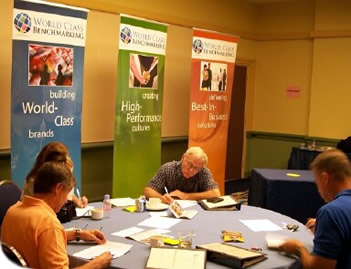 Employee Service Excellence. You can’t expect employees to deliver excellence when you haven’t created an environment where they can succeed. We’ll look at the very barriers that keep employees from providing consistent service day in and day out.
Employee Service Excellence. You can’t expect employees to deliver excellence when you haven’t created an environment where they can succeed. We’ll look at the very barriers that keep employees from providing consistent service day in and day out.
Selection. What do successful organizations do to acquire employees who are customer focused? We will talk about how best-in-business organizations recruit, interview, and select their employees.
Orientation and Development. Once we find the right fit employee, what do we do to make certain we get that individual off on the right foot? We will share best practices in a number of orientation and development efforts.
Communication. How do we get the messages that employees need in order to be successful in their own area? We will look at the lengths businesses goes to in communicating with their employees.
Creating a Culture of Accountability. In most organizations, accountability is defined as those actions pursuant to removing individuals from an organization. In reality, accountability is about an individual’s contribution to the organization. It’s about getting everyone “on the bus”. This is important, because most organizations find their employees spending the majority of the time focused on activities not aligned with the goals and directives of the organization. This experience would be to identify as an organization the measures you want to put into place in around three areas of focus:
Setting Clear Expectations. This is about defining performance around two areas of emphasis: The first is setting clear expectations regarding performance results (what you do). This is a balanced scorecard consisting of the following four-legged stool (financial results, customer service, employee excellence, and animal welfare) The second area of emphasis is around performance behaviors (how you do it). This is about internal and external service toward customers and employees. It’s also about being accountable to both the service standards and to institutional values.
Provide Developmental Feedback: This centers around two notions. The first is raising and resolving issues rapidly through appropriate feedback. As part of this we’ll explore 360-degree performance reviews. The second is providing developmental opportunities where employees could learn in a safe setting the skills they need to improve the performance and behavior.
Making Results Matter. This area also focuses on two issues: The first is around a formal/informal reward recognition strategy that celebrates individual, departmental, and organizational performance. The second issue is in dealing with poor performers who are not “getting on the bus”.
Developing an Employee Excellence/Loyalty Strategy. What are 12 things Gallup® says employees need to be successful in their job? They include the following:
- Do I know what is expected of me at work?
- Do I have the materials and equipment I need to do my work right?
- At work, do I have the opportunity to do what I do best every day?
- In the last seven days, have I received recognition or praise for doing good work?
- Does my supervisor, or someone at work, seem to care about me as a person?
- Is there someone at work who encourages my development?
- At work, do my opinions seem to count?
- Does the mission/purpose of my company make me feel my job is important?
- Are my co-workers committed to doing quality work?
- Do I have a best friend at work?
- In the last six months, has someone at work talked to me about my progress?
- This last year, have I had opportunities to learn and grow?
We’ll discuss ways in which the organization, departments, and managers specifically can work toward supporting these areas of improvement.
Creating a Culture of Collaboration. We identify those obstacles that are keeping departments and areas from better collaborating with other. We will identify initiatives that will foster a more collaborative organization as opposed to a more directive, silo approach. We’ll focus particularly on how the executive team in particular can link arms in working together as a team.
Widening the Circle of Influence. Too many throughout organizations are either focused on widening the area of control/responsibility or on laying blame on those who are in control. We need to focus on how the organization can teach staff to focus on widening their circle of influence instead. As an executive team, we’ll study those factors that seem to limit the organization’s ability to network and collaborate with each other.
Developing Entry Level Leaders. A large number of organizations have long-term tenure with the organization. As they prepare to retire, or as individuals are identified who are not in alignment with the organization, we need to prepare those younger members of the organization to successfully lead in their place. As an executive team we would identify those initiatives that would support the development of entry-level leaders.
Moving the Strategic Plan Forward. We’ll take time to identify those areas of focus for your organization, and map out a tactical and strategic plan of action for moving those initiatives forward